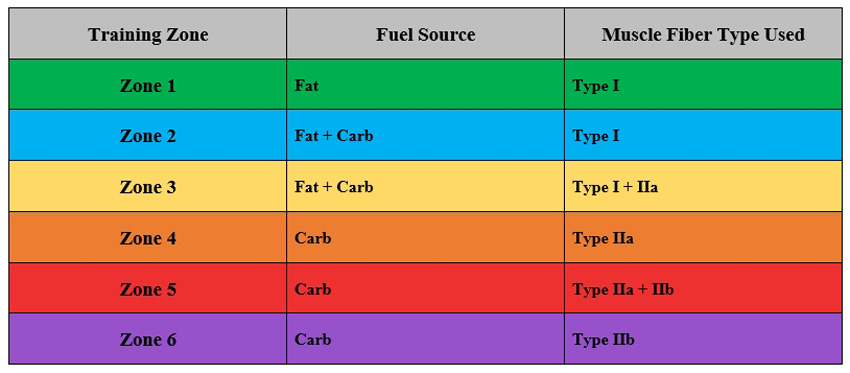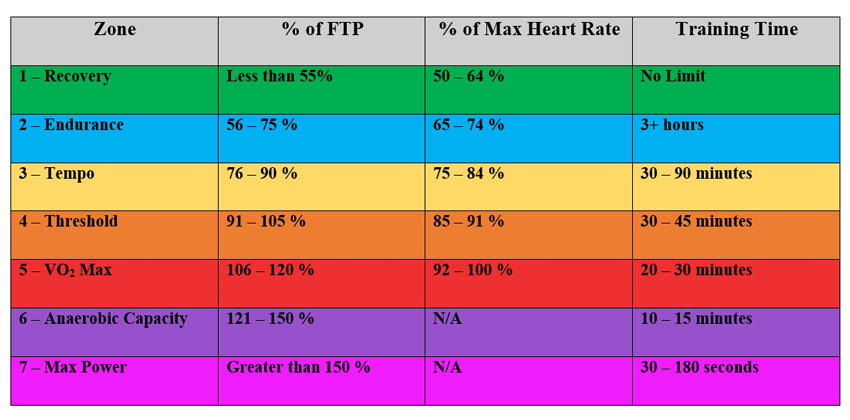Zone 2 Training for Cyclists: Why It Matters & How to Do It

Zone 2 training has always been a fundamental part of an endurance athlete’s training, even before the benefits were deeply understood.
Over two decades ago, Dr. Andy Coggan developed his power-based training zones, which are now widely used in cycling. As a result of his work, dedicated coaches and athletes have tailored their workouts to target specific zones and maximize the training effect. The specific benefits of Zone 2 training have more recently entered the spotlight, thanks to the work of Dr. Iñigo San Millán and others.
Dr. San Millán’s research on cellular metabolism at the University of Colorado’s School of Medicine has given him a unique understanding of the importance of mitochondrial function for health and athletic performance and how to leverage Zone 2 cardio to maximize that function. He applies this to his work with Team UAE Emirates.
This article will explain Zone 2 training, how it works, its performance benefits, and how best to implement it in your cycling training plan.
Energy Systems and Muscle Fibers
To understand how and why Zone 2 training works, we need a basic understanding of energy systems, muscle fibers, and how the two are linked.
Aerobic and Anaerobic Energy Systems Explained
Every moment we are alive, we require energy. Our bodies constantly break down (metabolize) fuel sources into smaller molecules called Adenosine Triphosphate (ATP), which are used for energy. The creation of ATP from macronutrients—primarily carbohydrates and fats—happens with oxygen (aerobic) or without (anaerobic). This process occurs in the mitochondria in our cells, commonly referred to as the ‘powerhouses of the cell.’
When exercise intensity is low to moderate, fuel breakdown happens in the presence of oxygen, called aerobic metabolism, which is the slower of the two. This system primarily uses fat with a smaller percentage of carbohydrates (glycogen); fat takes longer to break down than carbohydrates.
In contrast, when exercise intensity is high (lots of energy is needed quickly), the oxygen supply can’t keep up with energy demands. As a result, the anaerobic system takes over. This oxygen-free system is quicker and relies solely on carbohydrates for fuel because energy synthesis from glycogen is faster. As exercise intensity increases, the use of glycogen increases until the point fat isn’t used at all.
Types of Muscle Fibers
Our bodies have three muscle fiber types, slow-twitch (Type I) and fast-twitch (Type IIa and Type IIb). Slow-twitch muscle fibers are most active at lower intensities and speeds (aerobic): Zones 1 and 2, and thus use fat as their primary fuel source. Type II fibers are used at higher intensities/speeds (anaerobic): Zones 3 to 6, and exclusively use carbs as their fuel source.
As the intensity increases, muscle fiber activation changes in sequential order, as seen in the table below.

Type I (T1) muscle fibers have high fatigue resistance, the highest mitochondrial density (MD), and are efficient at breaking down fat for energy. Type II (T2) fibers have lower MD and fatigue faster than T1 but have a greater ability to use glycogen. Of the two T2 fibers, Type IIb has the highest capacity to use glycogen, the lowest MD, and fatigue the fastest.
Each person has a unique balance of muscle fiber types. For example, riders with a higher percentage of slow-twitch fibers will have better endurance (Lance Armstrong or Chris Froome). In contrast, riders with a higher proportion of fast-twitch fibers will be more explosive (Mark Cavendish or Tom Boonen).
What Is Zone 2 Training and What Does It Do?
What Is Zone 2 Training in Cycling?
Zone 2 is often called ‘base training,’ during which you develop an aerobic fitness base. Competitive cyclists usually spend a significant portion of their training hours in this zone because it benefits performance in all of the other zones, and much of a race is ridden at Zone 2 intensity.
You can ride almost indefinitely at this intensity if you’re adequately fueled. It doesn’t cause much damage, but it causes a potent adaptive response, meaning trained cyclists can do it almost daily.
What Is Considered Zone 2 Training?
Zone 2 cardio is low to moderate-intensity training at which most energy comes from fat, with only a small amount coming from glycogen stores. The gold standard for identifying Zone 2 (Z2) is using a blood lactate test (lactate of 2-3 mmol). However, this method isn’t practical for the general population.
The Z2 range is roughly 55 to 75% of functional threshold power (FTP) or 65 to 74% of max heart rate. Another way to tell you are in this zone is by using the talk test:
- Easy, flowing conversation – Zone 1
- Can hold a conversation, but speaking in shorter sentences – Zone 2
- Very difficult to talk – Zone 3-5
- Can’t speak – Zone 6/7
What Should Zone 2 Feel Like Cycling?
As mentioned above, Zone 2 should feel like cycling at a low-to-moderate pace: two to four on an RPE scale. You can hold a conversation at this output, but it is difficult, and you must speak in shorter sentences. Also, because it is a sub-lactate threshold, you will not feel the characteristic burning sensation that indicates lactate accumulation.
Deep Dive: What Does Zone 2 Training Do to You?
While exercising in Zone 2, you recruit Type I muscle fibers, utilizing mainly fat for energy. These slow-twitch fibers adapt to this exercise stressor by increasing mitochondrial density, among other responses.
Another significant effect of training in this zone is improved lactate clearance, the result of increased MD and more MCT-1 transporters (lactate carriers). Lactate is a byproduct of glycogen breakdown, which occurs mainly in the T2 muscle fibers during high-intensity exercise. Our bodies try to prevent the build-up of lactate by clearing it away. One of the primary ways our bodies clear lactate is through the T1 fibers.
Increased mitochondrial density improves your ability to metabolize fat (fat oxidation), which spares the glycogen stored in the muscle and liver for use during high-intensity efforts. As a result, riders well-trained in Zone 2 can make harder and longer efforts later in a race or ride.
Each individual reaches a point where lactate accumulation is faster than clearance. High-intensity training makes your T2 muscle fibers much more efficient at using glycogen, but they still rely on the lactate clearance capacity of the T1 fibers to delay exhaustion. T1 fibers take in lactate using a specific transporter protein (MCT-1), carrying it to their mitochondria for reuse as energy.
A final effect of Zone 2 cardio is the creation of new muscle capillaries, which enable more oxygen to be transported to the muscles. With oxygen reaching your muscles faster, you can remain in an aerobic state at higher power outputs.
The Benefits of Zone 2 Training
Most riders and fans of cycling know that the races are usually won through well-timed, powerful efforts that allow a rider to get ahead at a pivotal moment. So why is it so important to train at low intensity?
The benefits of Zone 2 cardio are many. For cyclists, this type of training impacts performance in several ways, as explained by what we discussed in the previous section.
- More efficient – Sustain higher power output at a lower effort that still favors fat for fuel.
- Increased sub-maximum output – Last longer and push harder at high intensities.
- Faster recovery – Less recovery time is needed between high-intensity efforts.
- Limited recovery needed – Trained cyclists can exercise Zone 2 almost daily without needing recovery the next day, allowing for higher training volumes.
General Health Benefits of Zone 2 Training
Zone 2 training also has tremendous benefits to overall health and longevity off the bike. The positive effect of this type of exercise on mitochondrial density and function can combat diseases like Type-2 diabetes and other metabolic conditions like hypertension and hypercholesterolemia. A 2020 study in JAMA estimated that 34.7% of the US population has metabolic syndrome, so this type of training could have a massive impact on addressing that issue.
Does Zone 2 Training Actually Work?
Zone 2 training works for a combination of reasons. Firstly, much of the time spent riding in a group or the peloton in a race is at Z2 pace, so you’re training to become more efficient at that output. Secondly, the adaptations from Zone 2 cardio in mitochondria spill over into other zones.
Lastly, the physiological stress of Z2 is minimal, meaning you can spend many hours in this zone without needing recovery the following day. In contrast, high-intensity exercise is stressful on the muscles, joints, and nervous system. Exercising too much at high intensities will lead to overtraining.
In addition, recent science suggests our tolerance to high-intensity training has an upper limit. Therefore, mixing high-intensity sessions with a large volume of low-to-moderate exercise is better for avoiding overtraining and maximizing performance.
Does Zone 2 Training Improve FTP?
Yes, Zone 2 training improves FTP. While riding at or around functional threshold power output, your Type II muscle fibers are doing most of the work, breaking down glycogen and producing lactate as a byproduct. Because Z2 training increases your ability to clear lactate, it takes longer to build up, pushing back your exhaustion point and improving your FTP.
Is Zone 2 Best for Fat Loss?
In general, cycling for weight loss is a great idea, but staying in zone 2 may not be the most efficient choice. Higher-intensity exercise uses more energy per minute of work. That said, Z2 uses a much higher percentage of fat for fuel and trains your body to become more efficient at using fat for energy. In addition, it requires less recovery time and is less strenuous, potentially making it easier to adhere to and do more for those targeting fat loss.
Does Cycling in Zone 2 Build Muscle?
Cycling in Zone 2 does build muscle but very slowly. However, it will tone and define your muscles by decreasing body fat. Z2 has a more significant impact on processes at a cellular level, such as increased mitochondrial density.
The most effective way to build muscle is through resistance training exercises like squats, lunges, hamstring curls, and wall sits. Read our guide on what muscles work when cycling for a more in-depth perspective on this topic.
Implementing Zone 2 Training
As we’ve seen, Zone 2 cardio should provide the base for our fitness, forming 60 to 75 percent of total training volume. However, you don’t need to dedicate whole sessions just to Z2; you can mix different zones to maximize your time on the bike and keep things interesting.
We recommend using a specific session or part of a session to target a particular energy system, such as a 90-minute Zone 2 ride finished with 15 minutes of Zone 5 intervals or a 30-minute Zone 4 effort.
How Long Should You Ride in Zone 2?
How long you should ride in Zone 2 each week depends on the available training time. While it’s recommended that competitive endurance athletes spend 60 to 75 percent of their training time in Zone 2, this doesn’t apply as strictly to a casual cyclist who rides two or three times per week for enjoyment and health.
Ideally, you would do three to four days a week of Z2 to improve your level and two to maintain it. For weekend warriors with some training history, target three or four 45-minute sessions of Zone 2 training per week to make improvements. Competitive riders should do one-hour sessions as their baseline fitness is higher.
If you’re riding on the road, it’s hard to stay in Zone 2 continuously, so you’ll need to increase the duration by about 50% to get the same amount of Zone 2 work done (one hour indoors = 90 minutes outdoors).
Stay in Zone 2 for uninterrupted periods to maximize the benefits and do it correctly. For example, if you’re out on the road and you stand up to get over a short hill, passing the lactate threshold, your body will require some time to readjust and reenter Zone 2, reducing the slow-twitch muscle fiber adaptations. For this reason, it’s easier and more time-effective to do Zone 2 training on an indoor trainer, where you can maintain a perfectly constant heart rate or power output.
Can You Overdo Zone 2?
Yes, you can overdo Zone 2 training if you are a new or intermediate cyclist. All training needs to be progressed gradually so your body can make necessary adaptations to avoid injury and overtraining. That said, an athlete or trained casual cyclist would find it extremely difficult to do so much that it would cause a problem.
Zone 2 Training with Heart Rate or Power: Setting Training Zones
Setting training zones is a process that involves testing yourself to figure out your baselines. You can find your FTP in three ways: using a standard 60-minute FTP test, a 20-minute test and calculating FTP based on that result, or a ‘ramp test’ done through Zwift or TrainerRoad. Check out our article on training with a power meter for step-by-step instructions.

You can also set training zones based on your max heart rate (220 minus your age). Alternatively, a more accurate formula was developed by Dr. Phil Maffetone to find the maximum aerobic heart rate (upper limit of Zone 2). The resulting number sets the upper limit of your Zone 2 (74% or MHR).
How Long Does It Take To See Results From Zone 2 Cardio?
It takes a relatively long time to see results from Zone 2 training, roughly two to four months, depending on your fitness level. Mitochondrial adaptations are slower than the strength and neuromuscular adaptations of high-intensity training, which you can notice as early as two weeks. For this reason, you usually see professional cyclists peaking after a couple of months of pre-season training, early-season training, and races.
Cross-training: Alternative Zone 2 Training Examples
Cross-training is one of the best ways to improve fitness and avoid the repetitive strain injuries associated with cardiovascular activities like cycling and running. Even elite-level cyclists such as Primos Roglic and Mathieu Van der Poel use activities like running to enhance their training. Some Zone 2 cardio examples that you can use to supplement your Z2 bike rides include:
- Running
- Treadmill walking with an incline
- Stair climbing machine
- Swimming
- Elliptical machine
Key Takeaways
The importance of Zone 2 training for performance is evident from its prioritization by world-class endurance athletes.
It makes you more efficient at low to moderate intensities, increases your ability to make hard efforts, and reduces your recovery time between high-intensity intervals.
Despite its profound effect, Z2 causes minimal physiological stress and can be repeated almost daily by trained individuals, allowing them to reach higher training volumes without overtraining. Aside from the benefits to athletes and exercisers, Zone 2 is a potent tool in combatting and helping reverse metabolic diseases like hypertension and diabetes.
Whether a competitive cyclist or a weekend warrior, you should integrate Zone 2 cardio into your weekly routine. Competitive riders should aim for three to four hours per week in Z2 spread over two or three rides, while casual cyclists can benefit from two or three 45-minute sessions.
Remember, Zone 2 is just one aspect of training and should be mixed in with high-intensity cardio, resistance training, and other activities to form a balanced and well-rounded lifestyle and training routine.
Related Posts
Best Endurance Road Bike Selection: Best Bikes for Long-Distance Comfort
What Is Randonneuring: A Complete Guide to Becoming a Randonneur
How to Complete Your First Century Ride — Crucial Tips for Beginners









